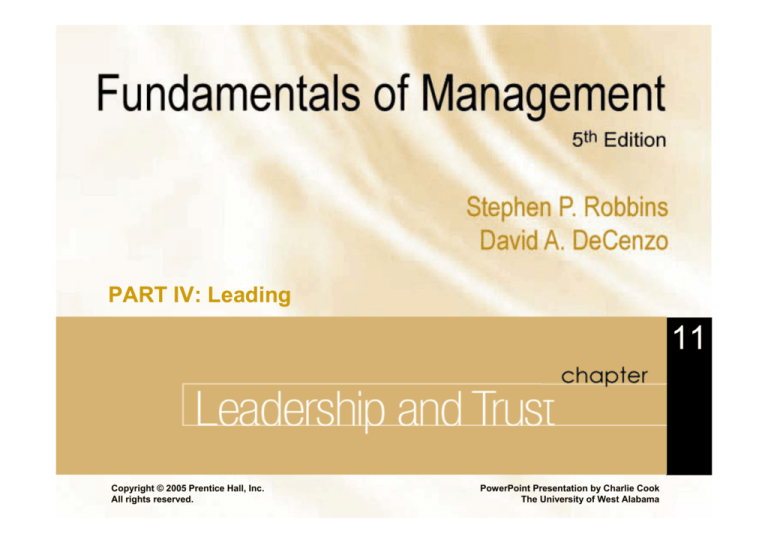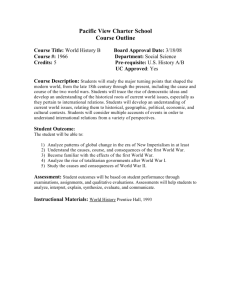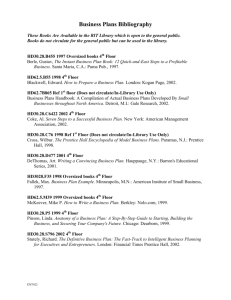
PART IV: Leading
Leadership and Trust
Chapter 11
Copyright © 2005 Prentice Hall, Inc.
All rights reserved.
PowerPoint Presentation by Charlie Cook
The University of West Alabama
11
Learning Outcomes
After reading this chapter, I will be able to:
1. Define leader and explain the difference between
managers and leaders.
2. Summarize the conclusions of trait theories of
leadership.
3. Describe the Fiedler contingency model.
4. Summarize the path goal model of leadership.
5. Explain situational leadership.
6. Identify the qualities that characterize charismatic
leaders.
Copyright © 2005 Prentice Hall, Inc. All rights reserved.
11–2
Learning Outcomes
After reading this chapter, I will be able to:
7. Describe the skills that visionary leaders exhibit.
8. Explain the four specific roles of effective team
leaders.
9. Identify the five dimensions of trust.
Copyright © 2005 Prentice Hall, Inc. All rights reserved.
11–3
Chapter Opening
• The selection process for the replacement of
Jack Welch, CEO of General Electric,
¾ took 6 years, 5 months, and 2 days.
¾ That process was lengthy, beginning in 1994 when
Jack Welch was approaching his 59th birthday.
• The goal of the process
¾ was to groom someone to step into Welch’s shoes
with out impacting GE’s earnings and growth of at
least 10 percent per year.
Copyright © 2005 Prentice Hall, Inc. All rights reserved.
11–4
• Welch and the Board each made lists of possible candidates
¾ assessed them according to the individuals’ talents and the gaps that
they had.
• Welch was a firm believer
¾ talent could be grown and nurtured in an environment where people
were given opportunities to excel.
• Over the next few years, the potential replacements were
given coaching and were evaluated
¾ on how well they developed themselves, reached their goals, and
demonstrated leadership.
• Each individual also had interactions with Board members
¾ aimed at getting the informal “feel” of working with each individual.
• Each December, the Chief of HR, and Jack Welch
¾ both provide their personal assessment of each candidate.
Copyright © 2005 Prentice Hall, Inc. All rights reserved.
11–5
• Three individuals were chosen as finalists and
given their own major divisions to head at GE.
• On Sept. 9, 2001, it was announced
¾ that Jeff Immelt had won the GE CEO “Sweepstakes.”
¾ September 11th happened, and Immelt was faced with
the
loss of two employees,
$600 million in insurance losses,
an anthrax attack at GE’s NBC studios,
and an aircraft engine operations slowdown.
¾ But Immelt was successful, demonstrating that all of his
training had paid off.
• Interestingly, the other two finalists were soon
offered CEO positions in other companies
¾ McNerney of the 3M Company and Nardelli of Home
Depot.
Copyright © 2005 Prentice Hall, Inc. All rights reserved.
11–6
Managers Versus Leaders
“Not all leaders are managers, nor are all
managers leaders.”
• Managers
¾ Persons whose influence on others is limited to the
appointed managerial authority of their positions to
reward and punish.
• Leaders
¾ Persons with managerial and personal power who can
influence others to perform actions beyond those that
could be dictated by those persons’ formal (position)
authority alone.
Copyright © 2005 Prentice Hall, Inc. All rights reserved.
11–7
Trait Theories Of Leadership
• Trait theories of leadership
¾ Theories that attempt to isolate characteristics that
differentiate leaders from nonleaders
Attempts
to identify traits that always differentiate
leaders from followers and effective leaders from
ineffective leaders have failed.
Attempts
to identify traits consistently associated with
leadership have been more successful.
Copyright © 2005 Prentice Hall, Inc. All rights reserved.
11–8
Six Traits That Differentiate
Leaders from Nonleaders
1.
2.
3.
4.
5.
6.
Drive
Desire to lead
Honesty and integrity
Self-confidence
Intelligence
Job-relevant knowledge
Source: Reprinted from “Leadership: Do Traits Really Matter?” by S. A. Kirkpatrick and E. A. Locke by permission
of Academy of Management Executive. May 1991, pp. 48–60. © 1991 by Academy of Management Executive.
Copyright © 2005 Prentice Hall, Inc. All rights reserved.
Exhibit 11.1
11–9
Behavioral Theories Of Leadership
• Behavioral theories of leadership
¾ Theories that attempt to isolate behaviors that
differentiate effective leaders from ineffective leaders
¾ Behavioral studies focus on identifying critical
behavioral determinants of leadership that, in turn,
could be used to train people to become leaders.
Copyright © 2005 Prentice Hall, Inc. All rights reserved.
11–10
Leadership Behaviors or Styles
• Autocratic style of leadership
¾ A leader who centralizes authority, dictates work methods,
makes unilateral decisions, and limits employee participation.
• Democratic style of leadership
¾ A leader who involves employees in decision making, delegates
authority, encourages participation in deciding work methods
and goals, and uses feedback to coach employees.
A democratic-consultative leader seeks input and hears
the concerns and issues of employees but makes the final
decision him or herself.
A democratic-participative leader often allows employees
to have a say in what’s decided.
Copyright © 2005 Prentice Hall, Inc. All rights reserved.
11–11
Leadership Behaviors or Styles (cont’d)
• Laissez-faire style of leadership
¾ A leader who gives employees complete freedom to
make decisions and to decide on work methods
• Conclusions about leadership styles
¾ The laissez-faire leadership style is ineffective.
¾ Quantity of work is equal under authoritarian and
democratic leadership styles
¾ Quality of work and satisfaction is higher under
democratic leadership.
Copyright © 2005 Prentice Hall, Inc. All rights reserved.
11–12
Continuum of Leader Behavior
Source: Adapted and reprinted by permission of the Harvard Business Review. An exhibit from
“How to Choose a Leadership Pattern” by R. Tannenbaum and W. Schmidt, May–June 1973.
Copyright © 1973 by the President and Fellows of Harvard College; all rights reserved.
Copyright © 2005 Prentice Hall, Inc. All rights reserved.
Exhibit 11.2
11–13
The Ohio State Studies
• Studies that sought to identify independent
dimensions of leader behavior
¾ Initiating structure
The
extent to which a leader defines and structures his
or her role and the roles of employees to attain goals
¾ Consideration
The
extent to which a leader has job relationships
characterized by mutual trust, respect for employees’
ideas, and regard for their feelings
Copyright © 2005 Prentice Hall, Inc. All rights reserved.
11–14
The University Of Michigan Studies
• Studies that sought to identify the behavioral
characteristics of leaders related to performance
effectiveness
¾ Employee oriented
A
leader who emphasizes interpersonal relations, takes
a personal interest in the needs of employees, and
accepts individual differences.
¾ Production oriented
A
leader who emphasizes technical or task aspects of a
job, is concerned mainly with accomplishing tasks, and
regards group members as a means to accomplishing
goals.
Copyright © 2005 Prentice Hall, Inc. All rights reserved.
11–15
The
Managerial
Grid
A two-dimensional
view of leadership
style that is based on
concern for people
versus concern for
production
Source: Adapted and reprinted by permission of the Harvard Business Review. An
exhibition from “Breakthrough in Organization Development” by R. R. Blake, J. A.
Mouton, L. B. Barnes, and L. E. Greine November–December 1964, p. 136.
Copyright © 1964 by the President and Fellows of Harvard College; all rights reserved.
Copyright © 2005 Prentice Hall, Inc. All rights reserved.
Exhibit 11.3
11–16
Contingency Theories Of Leadership
• Fiedler contingency leadership model
¾ The theory that effective group performance depends
on the proper match between the leader’s style of
interacting with employees and the degree to which
the situation gives control and influence to the leader
Uses
Least-preferred co-worker (LPC) questionnaire, to
measure the leader’s task or relationship orientation.
Identified
three situational criteria—leader member
relations, task structure, and position power—that
could be manipulated match an inflexible leadership
style.
Copyright © 2005 Prentice Hall, Inc. All rights reserved.
11–17
The Findings of the Fiedler Model
Exhibit 11.4
Copyright © 2005 Prentice Hall, Inc. All rights reserved.
11–18
Contingency Theories…(cont’d)
• Path-goal theory
¾ The theory that it is a leader’s job to assist followers
in attaining their goals and to provide the necessary
direction and support
¾ A leader’s motivational behavior:
Makes
employee need satisfaction contingent on
effective performance.
Provides the coaching, guidance, support, and rewards
that are necessary for effective performance.
¾ Assumes that the leader’s style is flexible and can be
changed to adapt to the situation at hand.
Copyright © 2005 Prentice Hall, Inc. All rights reserved.
11–19
Path-Goal Leadership Behaviors
• Directive leader
¾ Lets employees know what is expected of them, schedules work
to be done, and gives specific guidance as to how to accomplish
tasks.
• Supportive leader
¾ Is friendly and shows concern for the needs of employees.
• Participative leader
¾ Consults with employees and uses their suggestions before
making a decision.
• Achievement-oriented leader
¾ Sets challenging goals and expects employees to perform at
their highest levels.
Copyright © 2005 Prentice Hall, Inc. All rights reserved.
11–20
Path-Goal Theory
Exhibit 11.5
Copyright © 2005 Prentice Hall, Inc. All rights reserved.
11–21
Other Contingency Leadership Models
• Leader-participation model (Vroom, Yetton and
Jago)
¾ Provided a sequential set of rules for determining the
form and amount of participation a leader should
exercise in decision making according to different
types of situations.
The
model was a decision tree incorporating seven
contingencies (whose relevance could be identified by
making yes or no choices) and five alternative leader
ship styles.
¾ Assumed an adaptable leadership style.
Copyright © 2005 Prentice Hall, Inc. All rights reserved.
11–22
Contingency Variables in the Revised
Leader-Participation Model
• QR: Quality Requirement
• CO: Employee Conflict
• CR: Commitment
Requirement
• SI: Employee Information
• LI: Leader Information
• GD: Geographical
Dispersion
• ST: Problem Structure
• CP: Commitment
Probability
• GC: Goal Congruence
Source: V. H. Vroom and A. G. Jago, The New Leadership:
Managing Participation in Organizations (Upper Saddle River, NJ:
Prentice Hall, 1988), pp. 111–12. Reprinted by permission of
Prentice Hall, Inc., Upper Saddle River, New Jersey.
Copyright © 2005 Prentice Hall, Inc. All rights reserved.
• TC: Time Constraint
• MT: Motivation Time
• MD: MotivationDevelopment
Exhibit 11.6
11–23
Situational Leadership
• Situational leadership theory (SLT)
¾ Leaders should adjust their leadership styles—telling,
selling, participating, and delegating—in accordance
with the readiness of their followers.
Acceptance:
Leader effectiveness reflects the reality
that it is the followers who accept or reject the leader.
Readiness:
a follower’s ability and willingness to
perform.
At
higher levels of readiness, leaders respond by
reducing control over and involvement with employees.
Copyright © 2005 Prentice Hall, Inc. All rights reserved.
11–24
Hersey and Blanchard’s
Situational Leadership®
Model
Exhibit 11.7
Source: Reprinted with permission from the Center for Leadership Studies.
Situational Leadership® is a registered trademark of the Center for
Leadership Studies, Escondido, California. All rights reserved.
Copyright © 2005 Prentice Hall, Inc. All rights reserved.
11–25
Emerging Approaches To Leadership
• Charismatic leadership theory
¾ Followers make attributions of heroic or extraordinary
leadership abilities when they observe certain
behaviors
People
working for charismatic leaders are motivated to
exert extra work effort and, because they like and
respect their leaders, express greater satisfaction.
¾ Charisma leadership appears to be most appropriate
when the followers’ task has a ideological component
or when the environment involves a high degree of
stress and uncertainty.
Copyright © 2005 Prentice Hall, Inc. All rights reserved.
11–26
Charismatic Leadership
• A charismatic leader influences followers by:
¾ Stating a vision that provides a sense of community
by linking the present with a better future.
¾ Communicating high expectations and expressing
confidence that followers can attain them.
¾ Conveying, through words and actions, a new set of
values, and by his or her behavior setting an example
for followers to imitate.
¾ Making self-sacrifices and engaging in unconventional
behavior to demonstrate courage and convictions
about the vision.
Copyright © 2005 Prentice Hall, Inc. All rights reserved.
11–27
Key Characteristics of Charismatic Leaders
• Self-confidence
• Vision
• Ability to articulate the vision
• Strong convictions
• Behavior that is out of the ordinary
• Appearance
• Environmental sensitivity
Source: Based on J. A. Conger and R. N. Kanungo, “Behavioral Dimensions
of Charismatic Leadership,” in J. A. Conger and R. N. Kanungo, Charismatic
Leadership (San Francisco: Jossey-Bass, 1988), p. 91.
Copyright © 2005 Prentice Hall, Inc. All rights reserved.
Exhibit 11.8
11–28
Visionary Leadership
“A vision should create enthusiasm, bringing
energy and commitment to the organization.”
¾ The key properties of a vision are inspirational
possibilities that are value centered, realizable, and
have superior imagery and articulation.
• Visionary leadership
¾ The ability to create and articulate a realistic, credible,
attractive vision of the future that grows out of and
improves upon the present
Copyright © 2005 Prentice Hall, Inc. All rights reserved.
11–29
Skills of Visionary Leaders
• The ability to explain the vision to others.
¾ Make the vision clear in terms of required actions and
aims through clear oral and written communication.
• The ability to express the vision not just verbally
but through the leader’s behavior.
¾ Behaving in ways that continually convey and
reinforce the vision.
• The ability to extend the vision to different
leadership contexts.
¾ Sequencing activities so the vision can be applied in a
variety of situations
Copyright © 2005 Prentice Hall, Inc. All rights reserved.
11–30
Transactional Leaders versus
Transformational Leaders
• Transactional leaders
¾ Leaders who guide or motivate their followers toward
established goals by clarifying role and task
requirements.
• Transformational leaders
¾ Leaders who inspire followers to transcend their own
self-interests for the good of the organization and are
capable of having a profound and extraordinary effect
on followers.
Copyright © 2005 Prentice Hall, Inc. All rights reserved.
11–31
The Challenge of Team Leadership
• Becoming an effective team leader requires:
¾ Learning to share information.
¾ Developing the ability to trust others.
¾ Learning to give up authority.
¾ Knowing when to leave their teams alone and when
to intercede.
• New roles that team leaders take on
¾ Managing the team’s external boundary
¾ Facilitating the team process
Copyright © 2005 Prentice Hall, Inc. All rights reserved.
11–32
Team Leader Roles
Exhibit 11.9
Copyright © 2005 Prentice Hall, Inc. All rights reserved.
11–33
Other Leadership Variables
• National culture
¾ Leadership styles reflect the cultural conditions that
followers have come to expect.
Leadership
theories developed in the United States
have an American bias.
¾ Power distance varies among cultures and affect
participative management’s effectiveness
High
power distance = autocratic leadership style
Low power distance = participative leadership style
Copyright © 2005 Prentice Hall, Inc. All rights reserved.
11–34
Other Leadership Variables
• National culture
¾ Leadership styles reflect the cultural conditions that
followers have come to expect.
Leadership
theories developed in the United States
have an American bias.
• Power distance
¾ Varies among cultures and affect participative
management’s effectiveness
High
power distance = autocratic leadership style
Low power distance = participative leadership style
Copyright © 2005 Prentice Hall, Inc. All rights reserved.
11–35
Other Leadership Variables (cont’d)
• Emotional Intelligence (EI)
¾ Considered to be the trait difference that makes an
individual into a star performer
¾ Is an essential element of effective leadership
• Components of EI
¾ Self-awareness
¾ Self-management
¾ Self-motivation
¾ Empathy
¾ Social skills
Copyright © 2005 Prentice Hall, Inc. All rights reserved.
11–36
Substitutes for Leadership
• Employee characteristics
¾
¾
¾
¾
Experience
Training
Professional orientation
Indifference toward
organizational regards
• Organizational
characteristics
¾ Explicit formalized goals
¾ Rigid rules and procedures
¾ Cohesive work groups
• Job
characteristics
¾ Unambiguous
¾ Routine
¾ Intrinsically satisfying
Copyright © 2005 Prentice Hall, Inc. All rights reserved.
11–37
Five Dimensions of Trust
• Integrity
¾ Honesty and truthfulness
• Competence
¾ Technical and interpersonal knowledge and skills
• Consistency
¾ Reliability, predictability, and good judgment
• Loyalty
¾ Willingness to protect and save face for a person
• Openness
¾ Willingness to share ideas and information freely
Source: Adapted and reproduced with permission of publisher from J. K. Butler Jr. and R. S. Cantrell,
“A Behavioral Decision Theory Approach to Modeling Dyadic Trust in Superiors and Subordinates.”
Copyright © 2005 Prentice Hall, Inc. All rights reserved.
Exhibit 11.10
11–38
Types Of Trust
• Deterrence-based trust
¾ Trust based on fear of reprisal if the trust is violated
• Knowledge-based trust
¾ Trust based on the behavioral predictability that
comes from a history of interaction
• Identification-based trust
¾ Trust based on an emotional
connection between the parties
Copyright © 2005 Prentice Hall, Inc. All rights reserved.
11–39







